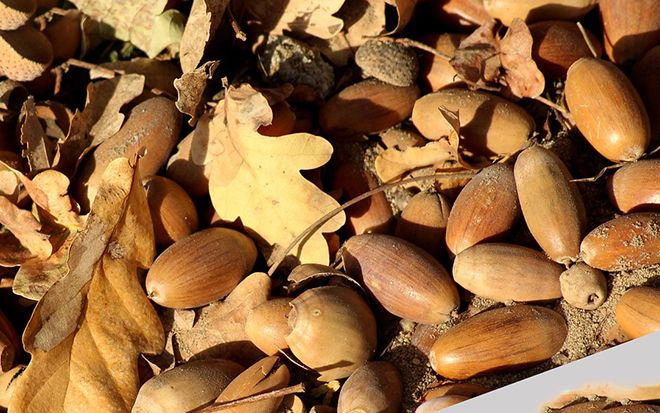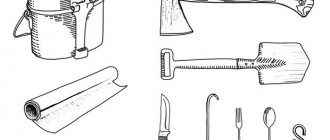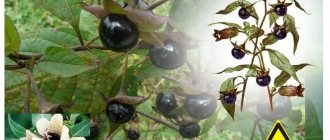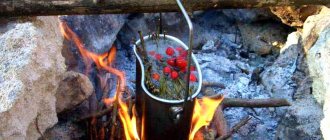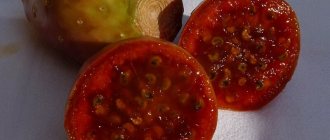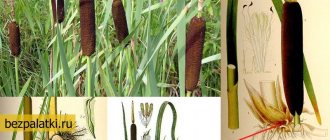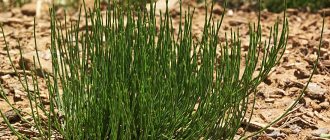An acorn (lat. glans) is the fruit of plants that belong to the Beech family - chestnut, beech, oak. However, according to a long-established tradition, the fruits of the latter are most often called this way. They have an unusual shape - a small smooth nucleolus, which is enclosed in a cap (plush), reaches from 10 to 40 mm in length. The fruits usually ripen in the fall. The collection begins in September and continues until the end of October. Acorns are a storehouse of useful substances, so they are used not only as animal feed, but also for cosmetic purposes, and also as a food product. In addition, their healing properties are also highly valued.
Composition and calorie content of acorns
The energy value of acorns is impressive, and the composition is quite diverse. The fruits contain protein substances containing glutamic acid, healthy fatty oil (up to 5%), sugars, glycoside quercetin, starch (up to 40%), various vitamins, micro- and macroelements.
The calorie content of raw acorns is 387 kcal per 100 g, of which:
- Proteins - 15 g;
- Fats - 86 g;
- Carbohydrates - 75 g;
- Water - 9 g;
- Ash - 35 g.
Vitamins per 100 g:
- Vitamin A, RE - 2 mcg;
- Vitamin B1, thiamine - 0.112 mg;
- Vitamin B2, riboflavin - 0.118 mg;
- Vitamin B5, pantothenic acid - 0.715 mg;
- Vitamin B6, pyridoxine - 0.528 mg;
- Vitamin B9, folate - 87 mcg;
- Vitamin RR, NE - 1.827 mg.
Macroelements per 100 g:
- Potassium, K - 539 mg;
- Calcium, Ca - 41 mg;
- Magnesium, Mg - 62 mg;
- Phosphorus, P - 79 mg.
Microelements per 100 g:
- Iron, Fe - 0.79 mg;
- Manganese, Mn - 1.337 mg;
- Copper, Cu - 621 μg;
- Zinc, Zn - 0.51 mg.
Essential amino acids per 100 g:
- Arginine - 0.473 g;
- Valine - 0.345 g;
- Histidine - 0.17 g;
- Isoleucine - 0.285 g;
- Leucine - 0.489 g;
- Lysine - 0.384 g;
- Methionine - 0.103 g;
- Threonine - 0.236 g;
- Tryptophan - 0.074 g;
- Phenylalanine - 0.269 g.
Essential amino acids per 100 g:
- Alanine - 0.35 g;
- Aspartic acid - 0.635 g;
- Glycine - 0.285 g;
- Glutamic acid - 0.986 g;
- Proline - 0.246 g;
- Serine - 0.261 g;
- Tyrosine - 0.187 g;
- Cysteine - 0.109 g.
Fatty acids per 100 g:
- Omega-6 - 4.596 g;
- Palmitic – 2.85 g;
- Stearic acid - 0.252 g;
- Oleic (omega-9) - 15.109 g;
- Linoleic – 4.596 g.
Dried acorns are characterized by a higher energy value and a greater number of constituent elements compared to raw ones.
The calorie content of dried acorns is 509 kcal per 100 g of edible part, of which:
- Proteins - 8.1 g;
- Fats - 31.41 g;
- Carbohydrates - 53.66 g;
- Water - 5.06 g;
- Ash - 1.78 g.
Vitamins per 100 g:
- Vitamin B1, thiamine - 0.149 mg;
- Vitamin B2, riboflavin - 0.154 mg;
- Vitamin B5, pantothenic acid - 0.94 mg;
- Vitamin B6, pyridoxine - 0.695 mg;
- Vitamin B9, folate - 115 mcg;
- Vitamin RR, NE - 2.406 mg.
Macroelements per 100 g:
- Potassium, K - 709 mg;
- Calcium, Ca - 54 mg;
- Magnesium, Mg - 82 mg;
- Phosphorus, P - 103 mg.
Microelements per 100 g:
- Iron, Fe - 1.04 mg;
- Manganese, Mn - 1.363 mg;
- Copper, Cu - 818 μg;
- Zinc, Zn - 0.67 mg.
Acorns have a beneficial effect on the human body due to the presence of numerous vitamins:
- Vitamin A . Promotes rapid healing of wounds, protection against colds, and slows down the aging process. Known for its antioxidant properties, which can be used for the prevention and treatment of cancer.
- Vitamin B1 . Participates in various metabolic processes. Has antioxidant properties.
- Vitamin B2 . Very important for mucous membranes. It is also called the vitamin of beauty and longevity. Promotes hair and nail growth. Takes part in metabolic processes and is useful for enhancing visual acuity. Promotes rapid adaptation of the eyes in the dark, reduces eye fatigue and prevents the occurrence of cataracts.
- Vitamin B6 . Takes part in the synthesis of protein and hemoglobin, helps reduce cholesterol and lipids in the blood. In addition, it prevents the aging process. It has a diuretic effect and has a beneficial effect on the condition of the skin.
- Vitamin B9 . It is necessary for each of us, since it takes part in hematopoiesis. In addition, it promotes the absorption of other vitamins, affects bone marrow function and helps maintain immunity.
- Vitamin PP . Helps normalize redox processes in the body, regulates the activity of the nervous system, and has a positive effect on digestive processes. This element protects the heart and blood vessels, helps normalize cholesterol levels, and remove toxins from the body. Regulates hormonal levels (promotes the formation of a number of thyroid hormones), stimulates the formation of serotonin - the hormone of joy.
Acorns are also rich in starch, highly digestible carbons and tannins. Thanks to the latter, they have a slightly bitter and astringent taste. But this is not a problem, you can easily get rid of it by soaking or heating, after which you can start preparing baked goods, side dishes and even coffee.
Acorns contain quercetin, a flavonol that has beneficial effects on the human body, confirmed by clinical studies. It has the following properties: anti-inflammatory, antihistamine, antiallergic. In addition, it has proven itself in the treatment and prevention of joint diseases.
Quercetin is a powerful antioxidant that can resist free radicals that destroy healthy cells and lead to the death of malignant tumors in the liver and intestines (confirmed by clinical studies in the USA). The qualities of a cardiotonic are manifested in the restoration of damaged and inflamed areas of the arteries.
Quercetin lowers blood pressure and reduces the damage from so-called “bad” cholesterol. In addition, studies have confirmed that quercetin reduces blood glucose levels and protects against encephalomyocarditis and meningococcal infection.
Interesting! Scientists believe that bread was originally made not from cereals, but from oak fruits.
New in blogs
The nutritional value of acorns has been known for a long time; they are very rich in easily digestible and quickly digestible carbohydrates, mainly starch (40%), tannins (5-8%), fatty oil (up to 5%), sugar, essential oil and other beneficial substances. In addition, acorns contain tannins, which give them an astringent and bitter taste. The main active part of tannins is tannin, which has an astringent, fixative, anti-inflammatory and anti-putrefactive effect, accelerates blood clotting, improves stomach function, and heals wounds. Acorns ripen in late September - early October.
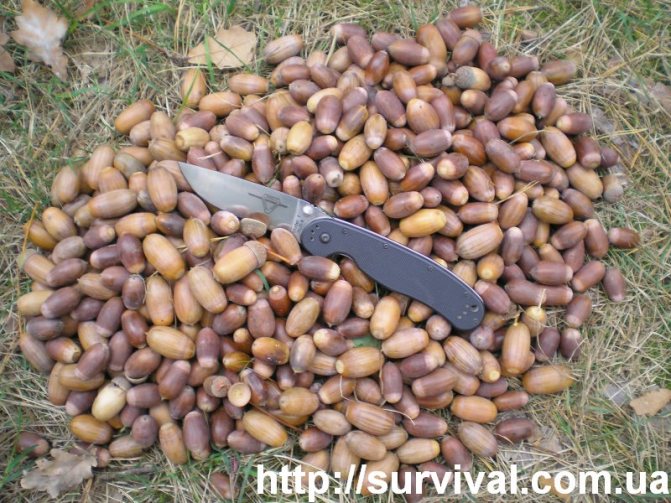
To get rid of the unpleasant, bitter taste that tannins give to acorns, they are peeled, cut into four parts, filled with water and soaked for two or three days, changing the water at least three times daily. To facilitate the process of peeling acorns, you need to first cut them crosswise, and then, using a knife, cut the shell on each half lengthwise and remove it in “layers.”

After soaking, the acorns should be cooked until they become soft, otherwise you simply won’t be able to grind them into flour. In addition, cooking removes any bitterness remaining after soaking.
After the acorns become soft, drain the water and proceed to perhaps the most difficult process in cooking - crushing. You can crush acorns with any available means - a pre-prepared wooden masher, the back of a knife, a stone, etc. The degree of grinding of acorns depends on the further purpose - if you decide to immediately make bread from the entire mass, then you don’t have to grind it too much, but if you plan to further dry and store flour for future use, then the finer the better, then this will help avoid problems during drying.
Add a little water to the resulting mass and form small cakes with a diameter of 6-7 cm and a height of up to 1 cm. Acorn dough, especially when mixed with plain water, does not have much stickiness and viscosity, so even those sizes will be easier to turn over. However, the size of the tortillas can be increased if you have two “frying pans”; the first with the tortilla is covered with the second and turned over. The flatbread simply falls from one frying pan to another, where it finishes frying.
The degree of readiness of the bread is determined visually. Of course, it looks scary, cooked in olive oil would be both more beautiful and tastier, but where can you get it, this oil, in a situation that will force you to bake bread from acorns? Prepared in this way, from only flour and water, acorn bread is quite edible, although it has a somewhat peculiar taste.
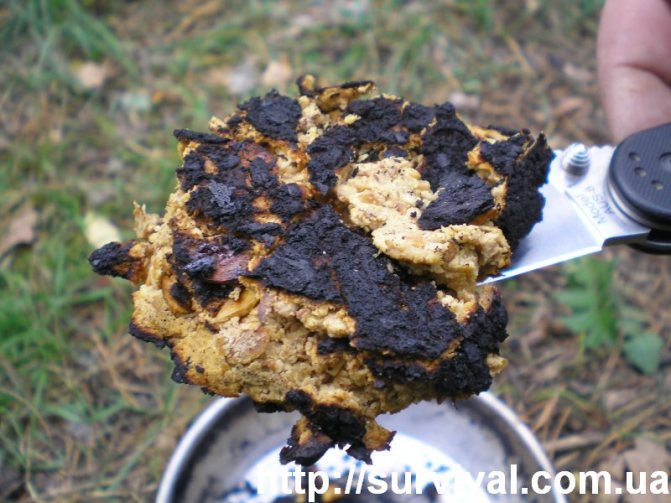
This article describes the “skeleton” of a recipe for making bread from acorns; all other options will directly depend on the ingredients and products you have with you - salt, sugar, butter, etc. In conclusion, some recommendations for the food use of acorns:
1. Soaked and boiled acorns do not have to be crushed, you can cut them smaller and simply fry them 2. Instead of bread, you can cook porridge from crushed acorns 3. Well-fried acorns can be brewed instead of coffee. Add a tablespoon to 0.2-0.25 liters of water and boil over low heat for 3-5 minutes 4. When preparing acorn flour for future use, you need to grind it as finely as possible, dry it well and store it in airtight containers or bags.
Useful properties of acorns
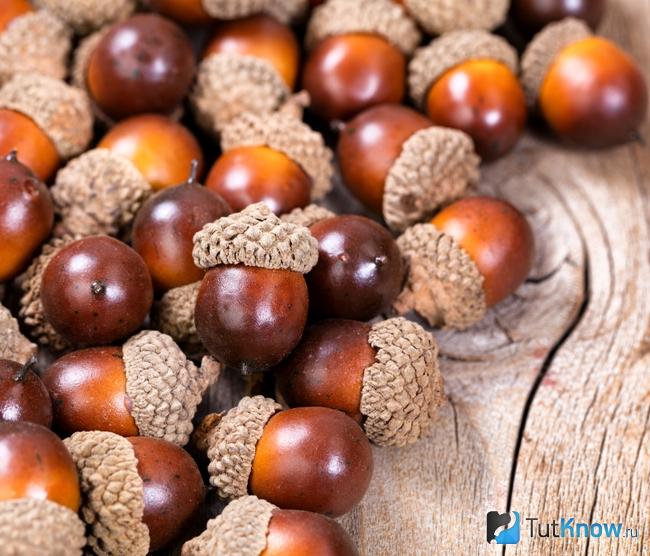
Once upon a time, the use of acorns for food was considered the lot of the poor in society in order to avoid starvation. And all because these fruits are food for wild and domestic animals. However, acorns have high nutritional and beneficial properties, thanks to which they are similar to natural coffee, cocoa beans and even olives.
Acorns have a number of medicinal properties. Among them are antihistamine, bactericidal, antiviral, anti-inflammatory and even antitumor.
The components of oak fruit have a positive effect on the nervous system - it helps to increase stress resistance. They can be used in the treatment of respiratory diseases - bronchitis, tracheitis and even asthma. With their help, the heart and blood vessels are treated. The healing power and benefits of acorns for diseases of the genitourinary system and stomach disorders are known. Their juice is used to treat gums and relieve toothache.
Most often, an infusion of the fruit, acorn coffee, is used as a medicine. It will be useful for people suffering from digestive diseases, as well as during poisoning of various etiologies. Traditional healers recommend taking this drink for 10-14 days, before eating 2 tbsp. l. 3 times a day.
Note! If you add milk to acorn coffee and sweeten it a little, you will get an excellent cough remedy. And for people suffering from high blood pressure and heart disease, this drink can replace real coffee.
Acorns are also useful in the treatment of diabetes; they are used to normalize sugar levels. In this case, you need to grate the fruits on a fine grater and take them for 1 week, 2 times a day, 1 teaspoon, with water. This is followed by a week of rest, at the same time you need to donate blood. After 3 courses, blood sugar is normalized.
Unripe fruits are also very useful. The juice is squeezed from green, peeled acorns and is used in the treatment of nervous disorders, anemia, inflammatory processes of the reproductive system and bladder.
Important! Even acorn caps are used in alternative medicine. An infusion of them is recommended to be taken in the treatment of pancreatitis.
Acorn flour (Recipe for besieged Leningrad)
“...Cut the peeled acorns into 4-5 pieces and add water.
Soak for two days, changing the water 3 times a day. Then fill the acorns with double the volume of clean water and put on fire. At the first signs of boiling, drain the water and pass the acorns through a meat grinder. Spread the resulting mass in a thin layer to dry in air and then in the oven. Grind the dried mass in a coffee mill. When you set the mill to coarse grinding, you get cereal for porridge, and when you set it to a finer setting, you get flour for flatbreads.”
Contraindications and harm of acorns

Quercetin, which is part of acorns, is very toxic to the human body. Therefore, eating fruits raw is unsafe for health. To eliminate the harmful effects of this compound, the acorns must first be filled with water and allowed to stand for 12-24 hours, periodically changing the water. Only after this can the fruits be subjected to heat treatment.
To avoid harm from acorns, it is not recommended to use them for people with stomach problems, as they are digested slowly.
In addition, a strict contraindication to the consumption of oak fruits is individual intolerance to the product.
Remember! It is recommended to harvest acorns in late September - early October, when they are fully ripe.
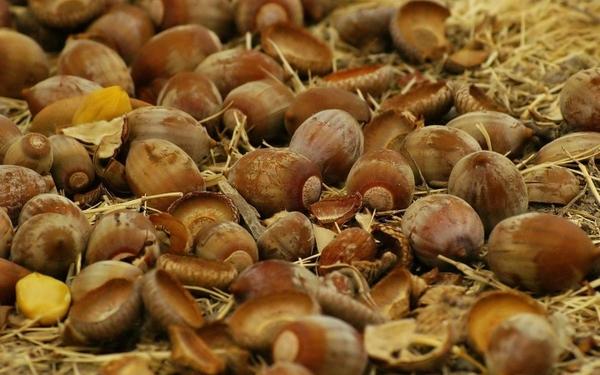
Acorns served as food for humans “even before the patroness of agriculture, Ceres, taught people how to cultivate grain,” as the ancient Romans believed. Archaeological scientists, not without reason, believe that the first “bread plant” should be considered not cereals - rye or wheat, but oak. For example, during excavations of ancient Trypillian settlements on the territory of modern Ukraine, dried and ground acorns were found. Our ancestors baked bread from this flour more than 5,000 years ago. Acorns are very nutritious, but tannins give them a bitter taste. If you remove these substances, you can prepare some original dishes from acorns. Tannins are easily removed by soaking. Those interested can try baking acorn “bread.” The recipe was borrowed from the book of the famous popularizer of botany N.M. Verzilina. It is better to collect acorns after the first frost. They are peeled, cut into four parts, filled with water and soaked for two days, changing the water at least three times daily. After this, the acorns are heated in water until boiling (2 parts water to 1 part acorns) and passed through a meat grinder. The resulting mass is dried - first in a thin layer in the air, then in a stove or oven until it begins to crunch like crackers. Dried acorns are crushed or ground in any way. With coarse grinding, you get cereal from which you can cook porridge, and from flour you can bake flat cakes. True, acorn dough does not have stickiness and viscosity, so the cakes break when turned over. To avoid this, it is advised to cover the frying pan with the flatbread with a second identical frying pan and turn them both over - the flatbread simply falls from one frying pan to the other, in which it is finished cooking. If you grease the cakes with jam, marmalade or cream and place them in a stack on top of each other, you will get a delicious cake. Soaked and lightly fried pieces of acorns can easily replace nut topping for a cake.
The nutritional value of acorns has been known for a long time; they are very rich in easily digestible and quickly digestible carbohydrates, mainly starch (40%), tannins (5-8%), fatty oil (up to 5%), sugar, essential oil and other beneficial substances.
In addition, acorns contain tannins, which give them an astringent and bitter taste. The main active part of tannins is tannin, which has an astringent, fixative, anti-inflammatory and anti-putrefactive effect, accelerates blood clotting, improves stomach function, and heals wounds. Acorns ripen in late September - early October.
To get rid of the unpleasant, bitter taste that tannins give to acorns, they are peeled, cut into four parts, filled with water and soaked for two or three days, changing the water at least three times daily.
To facilitate the process of peeling acorns, you need to first cut them crosswise, and then, using a knife, cut the shell on each half lengthwise and remove it in “layers.”
After soaking, the acorns should be cooked until they become soft, otherwise you simply won’t be able to grind them into flour. In addition, cooking removes any bitterness remaining after soaking.
After the acorns become soft, drain the water and proceed to perhaps the most difficult process in cooking - crushing. You can crush acorns with any available means - a pre-prepared wooden masher, the back of a knife, a stone, etc.
The degree of grinding of acorns depends on the further purpose - if you decide to immediately make bread from the entire mass, then you don’t have to grind it too much, but if you plan to further dry and store flour for future use, then the finer the better, then this will help avoid problems during drying.
Add a little water to the resulting mass and form small cakes with a diameter of 6-7 cm and a height of up to 1 cm. Acorn dough, especially when mixed with plain water, does not have much stickiness and viscosity, so even those sizes will be easier to turn over.
However, the size of the tortillas can be increased if you have two “frying pans”; the first with the tortilla is covered with the second and turned over. The flatbread simply falls from one frying pan to another, where it finishes frying.
The degree of readiness of the bread is determined visually. Of course, it looks scary, cooked in olive oil would be both more beautiful and tastier, but where can you get it, this oil, in a situation that will force you to bake bread from acorns? Prepared in this way, from only flour and water, acorn bread is quite edible, although it has a somewhat peculiar taste.
In conclusion, some recommendations for the food use of acorns:
1. Soaked and boiled acorns do not have to be crushed, you can cut them smaller and simply fry them 2. Instead of bread, you can cook porridge from crushed acorns 3. Well-fried acorns can be brewed instead of coffee. Add a tablespoon to 0.2-0.25 liters of water and boil over low heat for 3-5 minutes 4. When preparing acorn flour for future use, you need to grind it as finely as possible, dry it well and store it in airtight containers or bags.
Based on materials: https://survival.com.ua/sovs/sov20.html
How are acorns eaten?
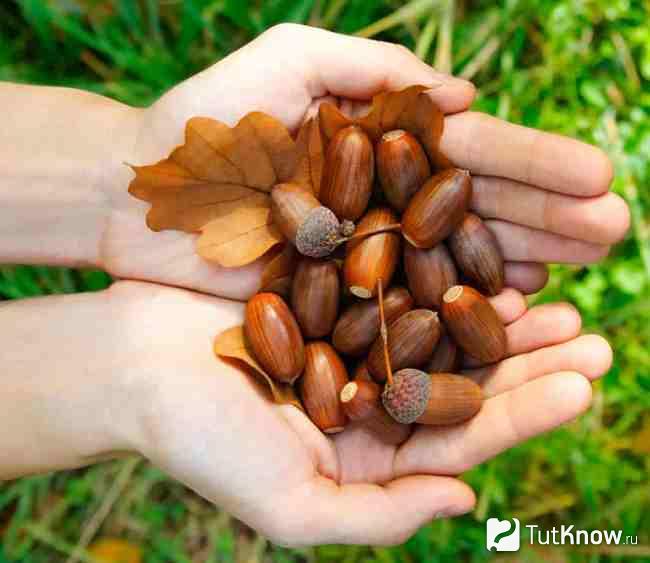
Most people do not perceive oak fruits as a food product and are in no hurry to introduce them into their diet. This is due to the strong aroma, widespread stereotypes that it is the food of squirrels and other rodents or the poor. However, many cuisines around the world have used acorns for centuries.
They are especially revered among some North American peoples and in Korea. Jelly and noodles made from starch made from acorns are popular in Korean cuisine. In Portugal, dishes made from oak fruits are served as colorful ecological food.
Only ripe acorns that have fallen from the tree are used for food, but it is important that they do not have wormholes, holes or other damage. Also suitable are fruits that can be removed from the branch by lightly pressing. The cap connecting the acorn to the stem must be present. Sprouted fruits should not be used.
In addition, it is worth remembering that raw acorns spoil very quickly, so it is not recommended to prepare too much raw material.
The most delicious fruits are swamp, Oregon white oak, blue oak and Emory, as they have the least quercetin. Red and black oak acorns are bitter in taste, so they take longer to cook.
The raw fruits have a bitter taste and are toxic due to the presence of quercetin. Therefore, before eating acorns, they are soaked in water. After removing tannins and heat treatment, they acquire a sweetish and mild taste.
Acorns are eaten either dried or fried, or coated in sugar. You can make candy from them by grinding them into fine crumbs, porridge and any baked goods - bread, cakes, pastries. In addition, this powder is considered an excellent thickener for liquid products and an ingredient for making coffee, both on its own and in combination with chicory, dandelion, and barley grains.
Application of oak acorns
Oak acorns are used in folk medicine. They destroy pathogenic microflora, normalize blood sugar concentrations, and have a beneficial effect on the heart muscle and vascular system. They help restore the functioning of the digestive tract after acute pathologies and chronic diseases.
The acorn has an unusual, but pleasant and pronounced taste, due to which it is used in cooking. It is suitable for preparing various dishes, baked goods and drinks that are not only tasty, but also healthy. In addition, oak fruits are widely used for making various crafts from natural materials.
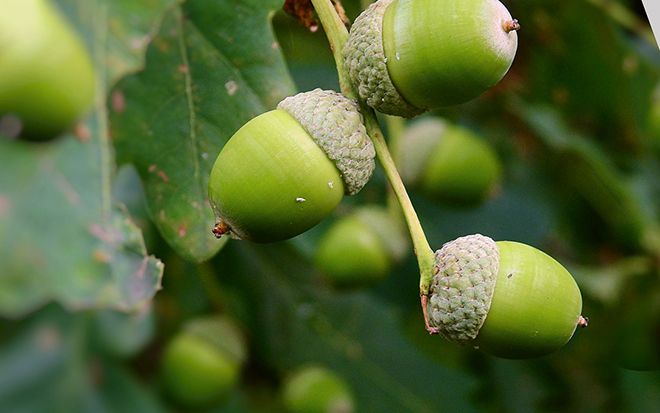
In cooking
Acorn flour is most often used for cooking. Method of its preparation:
- Pour the collected fruits into a hot frying pan. Fry, stirring constantly, over high heat for 1 minute. The shell should not be allowed to burn.
- While the nuts are warm, they need to be shelled. Cut the kernels into 4 parts. Use only those that have a soft milky or light brown color.
- Pour water at room temperature and soak for 2 days. Change the fluid 3 times every day.
- After 2 days, add clean water, bring to a boil, and drain.
- Pass the kernels through a meat grinder, place on a baking sheet and bake at +40°C in the oven until completely dry.
- Grind in a coffee grinder.
Self-harvested flour is used to prepare various recipes.
For the soup you will need:
- flour - 30 g;
- milk - 250 ml;
- sugar, salt, cinnamon - to taste.
You need to boil the water, slowly pour the flour into it, stir constantly, and cook until tender. Add milk, salt, sugar and spices. After boiling, turn off the heat. Add butter before serving.
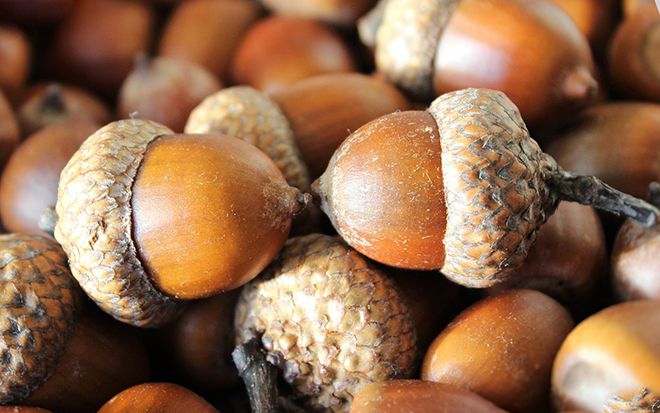
To prepare the flatbreads, you need to take:
- 30 g flour;
- 30 g sour cream;
- 20 g cheese;
- sugar, salt.
Heat the sour cream, add flour to it, boil for 1 minute, leave to cool. Grind the cheese and add it to the prepared mixture along with sugar and salt. Mix thoroughly, roll out small, thin cakes. Fry in a frying pan until golden brown.
We recommend that you familiarize yourself with Cypress spruce - cypress
For acorn dumplings you will need:
- flour - 2 cups;
- water - 100 ml;
- salt - ½ 1 tsp;
- onion - 2 pcs.;
- maximum fat sour cream or homemade cream;
- vegetable oil.
Pour cream into flour, add salt and water. Knead the dough, roll out to 5 mm thick. Cut into small squares. Boil in water with a little salt. Finely chop the onion and fry in a frying pan until golden brown. Mix with dumplings.
You can make dough to make delicious and healthy bread. To do this, you need to mix 100 g of wheat and 400 g of acorn flour. Add water (the amount depends on the flour), salt. Bake bread in the oven or slow cooker.
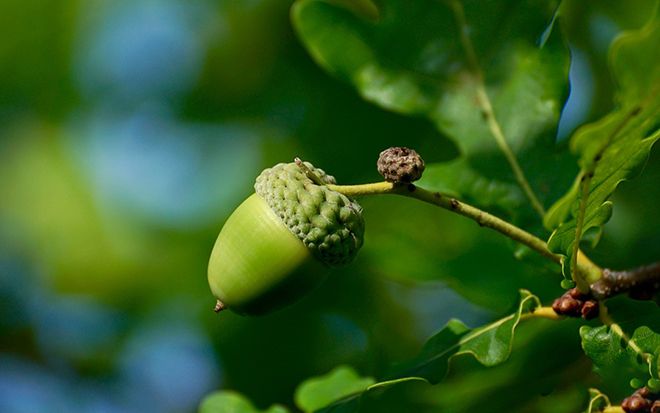
In folk medicine
The fruits, due to their healing composition, are used as an aid in the treatment of various diseases. In folk medicine, acorns are used to eliminate pathologies of the digestive system, pancreatitis, and diabetes.
Oak fruits also help get rid of impotence.
The use of acorns in various medicinal products improves the health of people with heart disease and heart rhythm disorders. They are especially useful for hypertension, as they normalize blood pressure.
To get rid of gastrointestinal disorders, you can use the following remedy:
- mix 1 tsp. crushed acorns with 200 ml of hot water, but not boiling water;
- Infuse the product for 15 minutes, strain;
- drink ½ glass 3 times a day.
The course of treatment lasts until the condition is completely normalized.
The following recipe is suitable for the treatment of pancreatitis:
- dry the fruit caps, but do not place them in direct sunlight;
- 1 tbsp. l. ingredients, pour 1 cup of boiling water;
- leave for 3 hours;
- take the decoction 3 times a day before the main meal; the initial dosage is ½ tsp, gradually the amount should be increased, bringing it to 70 ml.
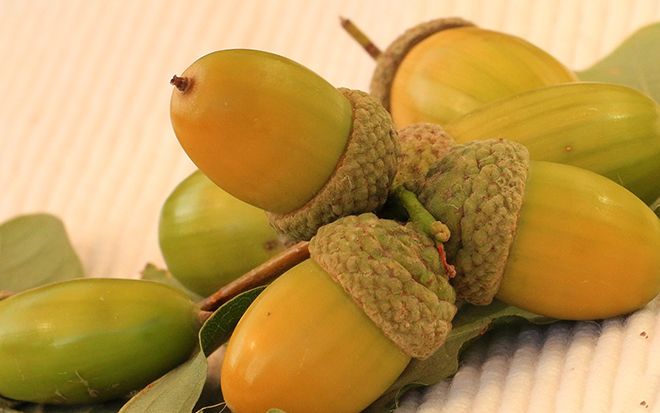
The fruits are used to relieve headache attacks, regardless of the cause of its occurrence. As a folk method, acorns are used in pediatrics to treat rickets and scrofula in children.
A coffee drink made from acorns helps strengthen the internal organs located in the abdominal cavity. It is drunk 2 times a day: in the morning and in the afternoon. This treatment method will help to quickly get rid of bronchitis and other diseases of the respiratory system, and reduce the frequency of bronchial asthma attacks.
Acorns are a natural, safe product, the use of which has no contraindications and does not provoke allergic reactions or other side effects.
For diabetes
It is impossible to completely cure diabetes mellitus with acorns. But due to such properties of oak fruits as normalization of blood glucose levels, it is possible to improve the general condition of a person and prevent the development of complications.
We recommend that you read: The harm and benefits of avocado
For diabetes mellitus it is recommended to use 2 recipes:
- Dry the acorns in the oven at high temperature until they acquire a reddish color. Grind in a coffee grinder or through a blender. Take the resulting powder in an amount of 1 tsp. 2 times a day before eating.
- Dry the fruits, peel them and chop them. Mix 1 cup of crushed kernels with 500 ml of water. Simmer over low heat for 30 minutes. After preparation, leave for 1 day. Boil again. Strain the broth, add 1 glass of high-quality vodka to the liquid. Take 3 medium sips 7 times a day. The course of treatment lasts 14 days.
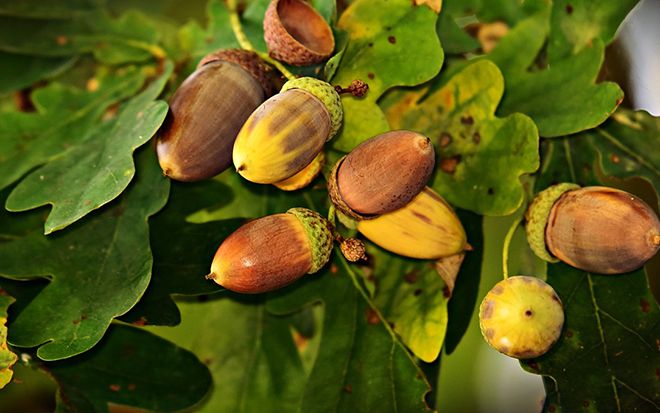
Acorns for diabetes are not an independent treatment method. It must be combined with traditional drug therapy.
From impotence
The fruits have an antibacterial effect, improve blood circulation, helping to cure diseases of the genitourinary system. They help restore male sexual power if impotence occurs.
To restore the functioning of the reproductive system, juice is used, which is prepared from green fruits. They must be passed through a meat grinder, the pulp must be squeezed out several times, collecting the juice in a glass container. Mix 3 tbsp. l. liquid with the same amount of honey. Use this amount 4 times a day, only on an empty stomach.
The drug must be taken over a long period of time. When problems with potency are just beginning, it can be used as the main method of treatment. If the situation worsens, complex therapy with medication is required.
Acorn recipes

To prepare dishes from acorns, it is best to use oak fruits collected in late September - the first half of October, dark brown in color. And they should be stored in a dry, well-ventilated place.
Recipes for delicious dishes with acorns:
- Acorn porridge . To prepare, you will need pre-dried oak fruits, which must be crushed into crumbs, as well as water, milk, melted butter and salt. Bring milk and water in a 2:1 ratio to a boil, add salt and add cereal (1 cup per 2.5 liters of liquid), stir well. When the cereal swells, add butter to taste and place in the oven for 40 minutes. The dish is served hot.
- Acorn bread. We start cooking traditionally by preparing the dough. To do this, dilute 1 packet (10-11 g) of dry yeast in 500 g of boiled water or milk, add a pinch of salt and a little sugar, mix thoroughly and add a little wheat flour. Then the prepared dough should be covered with a linen towel and placed in a warm place. After 20-30 minutes, knead the dough. Add 100 g of wheat flour, 800 g of acorn flour, and 50 g of melted butter to the dough. Mix well. Next, divide the dough into small portions, form the bread, and let it rise a little. Bake in the oven at 180-200°C for 30-40 minutes. Acorn bread is very useful for cleansing the body of toxic substances.
- Buttered acorn cakes . Ingredients: acorn flour (30 g), hard cheese (20 g), sour cream (30 g), a little sugar and sunflower oil. Warm up the sour cream. Add acorn flour. Stirring, bring the mixture to a boil. Next we cool. Grate the hard cheese and add to the already cooled mixture. Next, prepare the flatbreads in heated vegetable oil and sprinkle with sugar. Bon appetit!
- Acorn milk soup . You will need acorn cereal (30 g), milk or water (250 g), butter, sugar, cinnamon. Bring milk or water to a boil. Add acorn cereal. Cook over low heat, stirring thoroughly, for 10-15 minutes. You can add a piece of butter, sugar and cinnamon to taste.
- Dumplings made from acorn flour . Prepare the following ingredients: acorn flour (400 g), water or milk (100 g), a pinch of salt, 1 egg, sour cream or cream (100 g). From the above ingredients, knead a not very stiff dough, roll it out to 0.5 cm, cut into diamonds. Next, cook in salted water for 5-7 minutes. Dumplings are served hot with fried onions.
- Acorn pudding . You will need the following ingredients: acorn grits (40 g), apples (30 g), milk (60 g), hard cheese (20 g), sugar or honey to taste, cinnamon, jam, butter. Add acorn grits to boiling water. Cook until half cooked. Let the excess liquid drain, add milk, grated cheese, chopped apples, melted butter, mix well and bake in the oven at 170°C for 20-30 minutes. Serve with jam. Bon appetit!
To make coffee from acorns, you must first bake the oak fruits in the oven until they turn a slightly pinkish color. Next, cool, peel and grind. Pour boiling water over 1 teaspoon, let the drink brew for 5-7 minutes, then strain.
You can also make jelly . For this we also need cornstarch and sugar. The prepared coffee from acorns (about 200 g) must be brought to a boil, add 3 tablespoons of starch and bring to a boil again. After removing from heat, pour into cups and sprinkle with powdered sugar.
Don't forget that quercetin, a tannin found in acorns that is responsible for their bitter taste and toxicity in their raw form, is destroyed when heated. Therefore, heat treatment of fruits is mandatory.
A small word about Oak, its applied and ritual role among our ancestors.
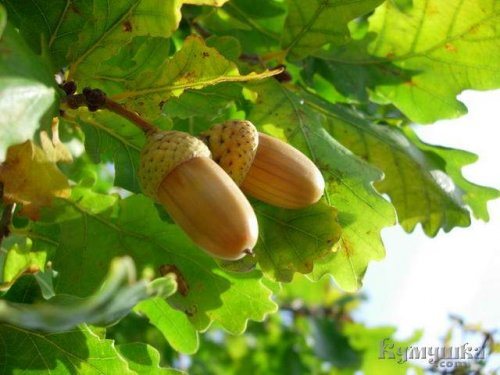
In Europe, until the Middle Ages, acorns were a staple food. And not only on the tables of commoners, but also of the nobility. American Indians of warm latitudes also successfully ate acorns. Plant food specialist Aill Gibbons writes: “During its existence, humanity has consumed many millions of tons more acorns than cereals. It is a pity that the food that nourished the human race at an early stage of its development is now forgotten and despised everywhere.” However, Europeans even today include acorns in their dishes, and they are also used to feed livestock. The Portuguese select and propagate oak trees with desirable fruit qualities - here is a review of their delicacy: “very tasty acorns, like nuts. Sweet and aromatic, slightly tart” (a species of holm oak, grows throughout the Mediterranean).
APPLICATION
In addition to the strongest wood, an important feature of oak in the applied sense is tannins used for tanning leather. The same property has been used since ancient times when pickling vegetables for future use: only 20 g of leaves per 3-liter jar of cucumbers is enough to ensure good taste and preservation of pickling.
Cork is obtained from the species Cork Oak.
For a long time in Rus' they used ink that does not fade over time - it was made from dried and ground galls - “ink nuts” that form on oak leaves (these are pathological formations caused by insects laying eggs in the leaves). Mixed with iron sulfate, these nuts produce durable black paint - the ink thanks to which the most ancient chronicles of our ancestors, the first handwritten books, have reached us. In the East, fabrics were dyed with such “oak ink”.
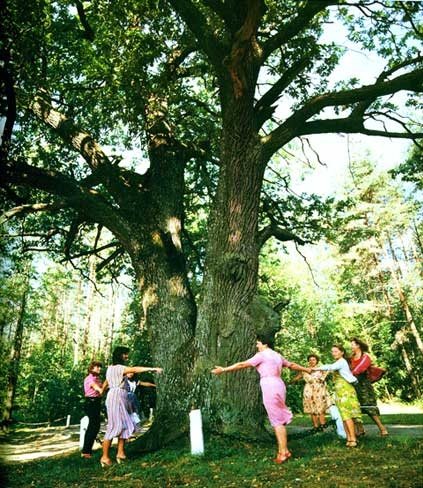
The medicinal use of oak parts has also been known since ancient times:
The bark has an astringent, anti-inflammatory, wound healing, hemostatic, restorative, diuretic effect, lowers blood pressure, increases the elasticity and strength of the walls of blood vessels.
Acorns are used for diarrhea.
The air in oak groves is filled with oak phytoncides (due to which other plants cannot coexist with it). When inhaled, general well-being improves, heart pain and headaches decrease, and sleep improves.
Read more about harvesting and using oak for health here: https://www.rezepty.by/retsepty-iz-lechebnogo-duba

OAK IN MYTHOLOGY
Among the Indo-Europeans and, in particular, the Slavs, the Oak has been revered from time immemorial as the King among trees; it symbolizes strength, strength and masculinity. It is the Oak that in folklore and folk magic acts as the World Tree. In the pagan worldview, this powerful tree is dedicated to the God of thunder and war - Perun. Under the powerful crowns of the Oak, prayers, sacrifices and trials were performed, military councils and meetings were held. Read more about Oak in mythology here: https://www.swarog.ru/d/dub8.php
OAK IN THE YARD - FOOD ON THE TABLE
As we already know from the beginning of the article, oak fruits have been used as food since ancient times! Tannins give acorns an astringent, bitter taste, which can be removed by soaking.
BASIC PROCESSING OF ACORN FOR FOOD
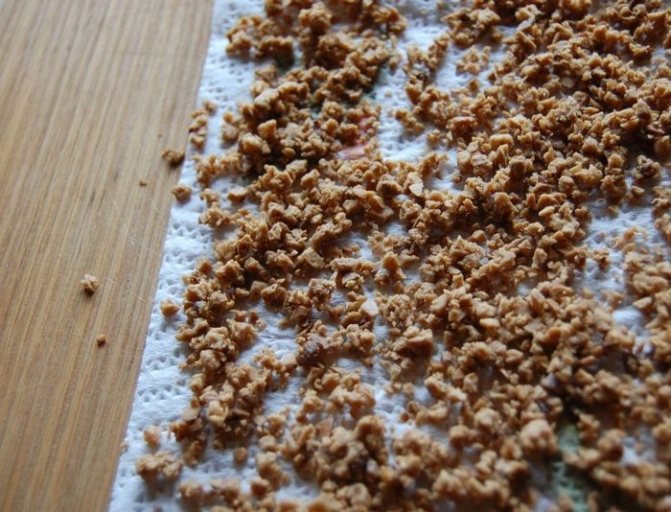
1) Peel the wood peel, cut into 4 parts and fill with water. 2) Soak the acorns for two days, rinsing them and changing the water at least 3 times a day (it will turn tea-colored, drawing out tannic acid). 3) Place in a saucepan, add water and heat to a boil (no need to boil). 4) Pass the swollen acorns through a meat grinder. 5) Spread the resulting slurry in a thin layer on a flat surface and dry. 6) Next, dry the acorns in the oven over low heat until they begin to crunch like crackers. 7) Pound in a mortar or grind with a coffee grinder. With coarse grinding, you get cereal - for porridge, grinding finely, you get flour - for baking flatbreads and bread.
Acorn recipes
Acorn flour (recipe for besieged Leningrad).
“...Cut the peeled acorns into 4-5 pieces and add water. Soak for two days, changing the water 3 times a day. Then fill the acorns with double the volume of clean water and put on fire. At the first signs of boiling, drain the water and pass the acorns through a meat grinder. Spread the resulting mass in a thin layer to dry in air and then in the oven. Grind the dried mass in a coffee mill. When you set the mill to coarse grinding, you get cereal for porridge, and when you set it to a finer setting, you get flour for flatbreads.” Acorn milk soup. Pour the acorn cereal into boiling water in a thin stream, stirring all the time, cook until the cereal is ready, then add milk, sugar, salt and bring the soup to a boil. When serving, place a piece of butter in a bowl of soup. For 30 g of acorn cereal - 250 ml of milk, 5 g of sugar, 5 g of butter, 2 g of salt.
Sweet flatbreads made from acorn flour. Boil sour cream, add acorn flour, boil lightly, remove from heat and cool. Add grated cheese and sugar to the resulting mass, mix well, cut into flat cakes and brown in a frying pan. For 15 g of acorn flour - 10 g of cheese, 25 g of sour cream, ½ egg, 5 g of sugar, fat.
Acorn dumplings with lard. Eggs, salt, water are added to oak acorn flour and a loose dough is kneaded, which is rolled out ½ cm thick and cut into squares. Dumplings are boiled in salted water. Onions are fried with diced lard and mixed with boiled, strained dumplings. Cook the dumplings before serving. For 2 cups of acorn flour - ½ cup of water, 1 egg, ½ teaspoon of salt, 2 onions, 100 g of lard.
Coffee drink made from acorns. You need to collect ripe acorns, green in color, hard to the touch, if pressed with your finger, it means they are wormy. You need to dry it like this: spread it on a baking sheet in one layer and put it in a preheated oven for five minutes. During this time, most of the acorns will burst and turn dark brown. Then open the oven and dry for another hour. Make sure that the acorns do not burn. Then take them out and cool. When cool, peel and place in a jar with a tight lid. In order to prepare a coffee drink, you need to grind the acorns in a coffee grinder, brew it like coffee, at the rate of one teaspoon of powder per cup of water. Add sugar to taste. The resulting drink is quite tasty, somewhat reminiscent of cocoa with milk, and very tonic.
Acorn coffee. Ripe acorns are peeled, each cut into 3-4 pieces and dried in the oven. Then the acorns are fried, making sure that they do not burn, but turn into a brittle mass that can easily be turned into a brown powder in a coffee grinder. Brew and drink like regular coffee, with milk or sugar. Acorn coffee is especially useful for children suffering from scrofula and rickets (coffee strengthens the abdominal organs and eliminates hardening of the mesenteric glands). Children are given twice a day: morning and afternoon.
Acorn coffee jelly. Stir coffee with sugar, dissolve in a small amount of hot water, then add 180 ml of water and strain. Pour potato starch diluted in 20 ml of cold water into boiling coffee, pour into a glass and sprinkle with powdered sugar or granulated sugar to prevent the formation of a film. For 7 g of acorn coffee - 10 g of potato starch, 15 g of sugar, 200 ml of water.
Acorn pudding with apples. Place the acorn grits in boiling, lightly salted water and, stirring with a wooden paddle, cook until half cooked. Then put the cereal on a sieve, transfer it to a saucepan, add milk and cook until tender. Put egg yolks, mashed with sugar, finely chopped apples, butter into the cooked acorn grits, mix well and bake in the oven. When serving, pour the pudding with jam, which has been preheated. For 40 g of acorn cereal - 5 butter, 30 g apples, 1 egg, 15 g sugar, 60 ml milk, 30 g jam.
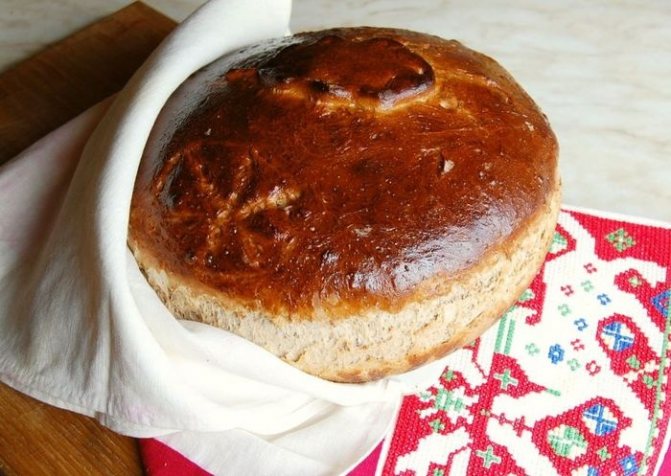
Recipes from acorns - soup, flatbreads, dumplings, coffee drink, porridge, jelly, pudding - here: https://vpomestie.ru/forum/18-45-1
Sources, in addition to those already indicated: Mints L. Under the centuries-old oak // "Around the World", 1993, No. 9. https://ru.wikipedia.org/wiki/Quercus
What can be made from acorns
0
— 8819
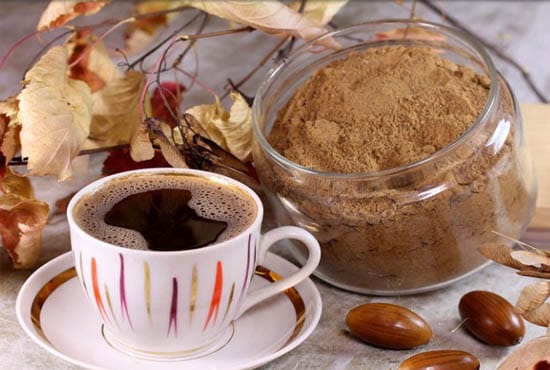
You need to collect ripe acorns, green in color, hard to the touch, if pressed with your finger, it means they are wormy. You need to dry it like this: spread it on a baking sheet in one layer and put it in a preheated oven for five minutes. During this time, most of the acorns will burst and turn dark brown. Then open the oven and dry for another hour. Make sure that the acorns do not burn. Then take them out and cool. When cool, peel and place in a jar with a tight lid. In order to prepare a coffee drink, you need to grind the acorns in a coffee grinder, brew it like coffee, at the rate of one teaspoon of powder per cup of water. Add sugar to taste. The resulting drink is quite tasty, somewhat reminiscent of cocoa with milk, and very tonic.
Coffee made from acorns.
Ripe acorns are peeled, each cut into 3-4 pieces and dried in the oven. Then the acorns are fried, making sure that they do not burn, but turn into a brittle mass that can easily be turned into a brown powder in a coffee grinder. Brew and drink like regular coffee, with milk or sugar. Acorn coffee is especially useful for children suffering from scrofula and rickets (coffee strengthens the abdominal organs and eliminates hardening of the mesenteric glands), as well as for coughs, bronchitis, asthma.. Children are given twice a day: in the morning and after lunch.
A coffee drink made from acorns is very useful for heart diseases.
Acorn coffee jelly. Stir coffee with sugar, dissolve in a small amount of hot water, then add 180 ml of water and strain. Pour potato starch diluted in 20 ml of cold water into boiling coffee, pour into a glass and sprinkle with powdered sugar or granulated sugar to prevent the formation of a film. For 7 g of acorn coffee - 10 g of potato starch, 15 g of sugar, 200 ml of water.
Acorn bread.
Acorns served as food for humans even before the patroness of agriculture, Ceres, taught people how to tillage - this is what the ancient Romans believed. Archaeological scientists, not without reason, believe that the first “bread plant” should be considered not cereals - rye or wheat, but oak. For example, during excavations of ancient Trypillian settlements on the territory of modern Ukraine, dried and ground acorns were found. Our ancestors baked bread from this flour more than 5,000 years ago. Acorns are very nutritious, but tannins give them a bitter taste. If you remove these substances, you can prepare some original dishes from acorns. Tannins are easily removed by soaking. Those interested can try baking acorn “bread.” The recipe was borrowed from the book of the famous popularizer of botany N.M. Verzilina. It is better to collect acorns after the first frost. They are peeled, cut into four parts, filled with water and soaked for two days, changing the water at least three times daily. After this, the acorns are heated in water until boiling (2 parts water to 1 part acorns) and passed through a meat grinder. The resulting mass is dried - first in a thin layer in the air, then in a stove or oven until it begins to crunch like crackers. Dried acorns are crushed or ground in any way. With coarse grinding, you get cereal from which you can cook porridge, and from flour you can bake flat cakes. True, acorn dough does not have stickiness and viscosity, so the cakes break when turned over. To avoid this, it is recommended to cover the frying pan with the flatbread with a second identical frying pan and turn them both over - the flatbread simply falls from one frying pan to the other, in which it is finished cooking. If you grease the cakes with jam, marmalade or cream and place them in a stack on top of each other, you will get a delicious cake. Soaked and lightly fried pieces of acorns can easily replace nut topping for a cake.
Medicinal use. The bark, leaves and fruits of oak are used for medicinal purposes. Tannins have been isolated from oak bark, solutions of which are used for inflammatory processes in the mouth, nose, larynx, and for the treatment of ulcers and burns. The bark is used as a strong astringent and strengthens blood vessels, and also as an anthelmintic. Oak bark is effective as an anti-inflammatory agent for diseases of the oral cavity (gingivitis, stomatitis, amphodontosis), pharynx, larynx, and pharynx. In addition, it is used to treat burns, skin diseases, wounds, and frostbite. Oak bark is used for mushroom poisoning and in the treatment of diarrhea. ! For mouth rinsing and compresses, prepare a decoction at the rate of 10-20 g of oak bark per 200 ml of water. Boil for 15-20 minutes, filter. ! An infusion of oak bark is prescribed for inflammation of the gastrointestinal tract, diarrhea, and dysentery. To do this, pour 1 teaspoon of crushed bark into 400 ml of cold boiled water. Leave for 8 hours and filter. Drink in sips throughout the day. Cannot be prescribed to children. ! A coffee drink made from acorns is very useful for heart diseases. ! For severe sweating of the feet, take baths with a decoction of oak bark (50-100 g per 1 liter of water). Use a decoction of the bark to wash your hair for dandruff. Terms and methods of procurement. Acorns are harvested in September-October, when they are fully ripe. Acorns spoil very quickly, so immediately after collection they are peeled, the cotyledons are separated and dried. The humidity of dry acorns should be no more than 11%. The bark is harvested in the spring during sap flow (April-May), from branches with a diameter of 10-20 cm without cracks and lichens. To remove the bark, circular cuts are made with a knife at a distance of 30 cm from one another, which are connected with a longitudinal cut. After this, the bark is easily removed. Dry it under a canopy with good ventilation, as well as in the sun. Shelf life: 5 years. The leaves are collected in the spring while they are young and sticky.
The use of acorns for diabetes.
1. For diabetes mellitus, grind dried oak acorns in a coffee grinder and take 1 tsp of this powder orally. an hour before meals in the morning and at night.
2. Grate the acorns on a fine grater. 1 teaspoon of acorns should be eaten half an hour to an hour before meals on an empty stomach, and in the evening, an hour after meals. You can drink water and eat nothing else.
Treatment is carried out according to the following scheme: consume acorns for a week, then rest for a week. Get a blood test this week. Then again a week of acorns - a week of rest and a blood test. Do this 2-3 times, but you can do this up to 4 times. After 3 sessions, blood sugar is normalized.
3. Add 1.5 liters of water to one glass of dry acorns minced without peel, boil for 30 minutes over low heat, leave for 1 day, boil again for 30 minutes and leave again for 1 day. Strain, add 1 glass of vodka to the broth, mix and drink 3 small sips 5-7 times a day, regardless of meals. The course of treatment is 2 weeks. Check your blood sugar and then act depending on the condition. The medicine must be kept in the refrigerator. In the future, to prevent sugar levels from rising, take this medicine 2 times a week.
4. One tablespoon of acorn coffee per 400 ml of boiling water, add sugar to taste. Take once a week. Drink in 3-4 doses in the early stages of diabetes.
Various folk recipes from acorns
Acorns have a bactericidal, enveloping, antitumor effect. They are often used in the treatment of the genitourinary system: they stop heavy menstruation, are used for female diseases, increase potency, and treat enuresis. Acorns are good for treating gums and toothache, and are useful for various types of poisoning. In addition, oak fruits have a beneficial effect on the digestive system: their decoction is used for indigestion, acute and chronic colitis.
Ripe oak fruits are collected and dried in a dark place for 3-4 weeks (you can use a dryer - at a temperature of 50 degrees for 2-3 days). Then the fruits are crushed and stored in a dry place. It is not recommended to harvest too many fruits - the raw materials quickly deteriorate.
For stomach upsets, traditional medicine recommends an infusion of acorns: pour 1 teaspoon of chopped fruits with a glass of boiling water, cool, strain. Take half a glass orally 3 times a day. The duration of the course is a month, after another month it is recommended to repeat it.
Coffee made from acorns is good for heart disease. The fruits need to be lightly fried until reddened, crushed and brewed like coffee. Add milk, sugar. This coffee is often recommended for children both as a regular drink and for coughs, bronchitis, and asthma.
To treat a hernia, a warm 25% tincture of acorns in red wine is used as a compress.
For problems associated with the genitourinary system, acorn juice is used. It is squeezed from green fruits, take 2-3 tablespoons with honey (1:1 ratio) on an empty stomach 3-4 times a day.
Pancreatitis: I have long paid attention to the original recipe of the Chisinau healer G. Kuznetsov, who advises collecting ripe acorns, but not dried on trees, but fresh ones, drying them in the shade, separating the “caps” from the acorns - pluses, 1 tablespoon of such “caps” pour 200 ml of boiling water for 2 – 3 hours, strain.
You need to start taking it with one teaspoon and gradually increase it to 60 - 70 ml per day. If the taste is unpleasant, then soak the bread in the infusion and take 3 times a day 30 minutes before meals. He also recommends eating acorns until the functioning of the pancreas returns to normal.
“Excavations on the territory of the Kirovograd region confirmed that more than five thousand years ago people here baked bread from acorns ground into flour. Oak has been in great honor among the Slavs from time immemorial. In pagan times, this powerful tree was dedicated to the god of lightning and thunder - Perun. Under the powerful crowns of the oak tree, sacrifices and trials were carried out, military councils were held, and all the most important issues were resolved. The beloved and revered plant is surrounded by legends and myths, sung in songs and poems, and endowed with lofty epithets. ...During excavations in Japan, an acorn was found, the age of which, as scientists determined, was 3800 years old. This acorn was planted - and it sprouted! Now it is already a respectable tree... ...Its leaves are also useful, especially when pickling vegetables for future use. Just 20 g of them per three-liter container of cucumbers is enough to ensure good taste and preservation of pickling. For a long time in Rus' they used ink that does not fade over time - it was also made from oak, more precisely, from dried and ground galls - nuts that form on oak leaves. Mixed with iron sulfate, these nuts produce durable black paint - the ink thanks to which the most ancient chronicles of our distant ancestors, the first handwritten books, have come down to us. One of the reasons that acorns gradually lost their nutritional value apparently lies in the fact that they contain the glycoside quercitrin and tannins, which give acorns a certain bitterness. But this bitterness is easily removed by heating...”
Acorn porridge. Acorns contain tannins that give them an astringent, bitter taste. These substances can be removed by soaking. The acorns are peeled, cut into four parts and filled with water. Soaking continues for two days, and the water is changed three times every day. Then transfer the acorns into a saucepan, add water and heat to a boil. Then the acorns are passed through a meat grinder and the resulting mass is dried, scattered in a thin layer on plywood. After preliminary drying in air, the acorns are dried in the oven until they begin to crunch like crackers. Dried acorns are pounded or ground in a coffee mill. With coarse grinding, you get cereal from which you can cook porridge, and from flour you can bake flat cakes.
Acorn flour (recipe from besieged Leningrad). “...Cut the peeled acorns into 4-5 pieces and add water. Soak for two days, changing the water 3 times a day. Then fill the acorns with double the volume of clean water and put on fire. At the first signs of boiling, drain the water and pass the acorns through a meat grinder. Spread the resulting mass in a thin layer to dry in air and then in the oven. Grind the dried mass in a coffee mill. When you set the mill to coarse grinding, you get cereal for porridge, and when you set it to a finer setting, you get flour for flatbreads.”
Acorn milk soup. Pour the acorn cereal into boiling water in a thin stream, stirring all the time, cook until the cereal is ready, then add milk, sugar, salt and bring the soup to a boil. When serving, place a piece of butter in a bowl of soup. For 30 g of acorn cereal - 250 ml of milk, 5 g of sugar, 5 g of butter, 2 g of salt.
Sweet flatbreads made from acorn flour. Boil sour cream, add acorn flour, boil lightly, remove from heat and cool. Add grated cheese and sugar to the resulting mass, mix well, cut into flat cakes and brown in a frying pan. For 15 g of acorn flour - 10 g of cheese, 25 g of sour cream, ½ egg, 5 g of sugar, fat.
0
Related:
- How to make a home altar
- How to make a mattress and pillows from medicinal herbs
- How to make biomass out of individuals...
- How much does it cost to make a revolution in Ukraine?
- Petr Garyaev: What can linguistic-wave genetics do for humans?
New articles
- Traditional treatment of goiter - thyroid gland
- Treatment of joints with folk remedies
- Kidney treatment with folk remedies
- Ammonia against insects and more...
- Useful properties of strawberry tails and preparing them for the winter
Latest articles
- How to make tea from twigs
- Cleansing blood vessels with folk remedies
- What does pomegranate cure? Pomegranate - heals everything!
Add a comment
Coffee with acorns
The aromatic drink will not only replace coffee beans, but will also benefit the body. It is recommended to take it for therapeutic and prophylactic purposes.
To make coffee, you need to collect the fruits between late September and October. They should be ripe, firm to the touch, and brown in color. If, when pressed with a finger, the pulp falls through, this indicates that it is wormy.
Pour water over the acorns and remove any that float to the surface (they are not suitable). Remove from the water, place on a baking sheet and place in a preheated oven for 10 minutes. Then peel (it’s easier to do this while the fruits are warm), grind through a meat grinder and dry again in the oven. Harvested raw materials can be stored for a long time in glass containers or paper, tightly closed bags.
We recommend that you read the Properties and uses of avocado oil
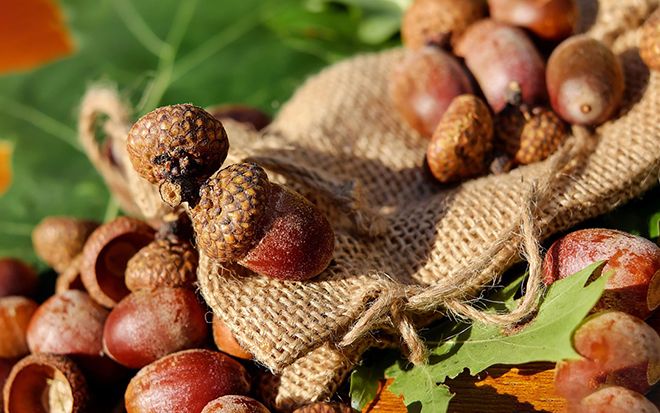
To prepare the drink, the prepared mixture must be ground in a blender to the state of flour and fried in a frying pan. The taste depends on how deeply the flour is fried. The oak fruit drink should be brewed in the same way as ordinary coffee beans. Dosage - 1 tsp. flour and 1 glass of water. After cooking, you can add milk or honey to taste.
The taste of the drink can be improved by adding some spices to it:
- cloves - will be especially useful for people who have problems with liver function;
- cardamom - recommended for an overactive gallbladder, frequent physical or emotional fatigue;
- black pepper - for men, pink pepper - for women;
- ginger - helps with diseases of the digestive system;
- cinnamon - for impaired heat exchange, depressive states, depressed psycho-emotional state;
- nutmeg - to normalize the functioning of the central nervous system and gain mental balance.
The drink is recommended for all people to drink in order to prevent viral and infectious diseases in the autumn and winter. It strengthens the immune system, invigorates, saturates with vital energy and relieves fatigue.
